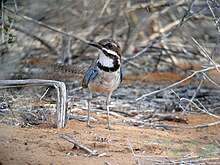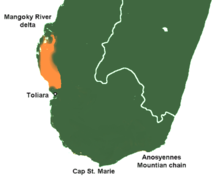Long-tailed Erdracke
| Long-tailed Erdracke | ||||||||||
|---|---|---|---|---|---|---|---|---|---|---|

Long-tailed Erdracke ( Uratelornis chimaera ) |
||||||||||
| Systematics | ||||||||||
|
||||||||||
| Scientific name | ||||||||||
| Uratelornis chimaera | ||||||||||
| Rothschild , 1895 |
The long-tailed Erdracke ( Uratelornis chimaera ) is endemic to Madagascar occurring bird from the family of the ground roller (Brachypteraciidae).
features
Long-tailed Erdracken reach a body length of 34 to 47 centimeters including the tail. The tail is a maximum of 28.5 centimeters. The head, neck and back are light brown with narrow dark brown stripes and speckles. The white throat is bordered by a wide black-brown band. The chest and belly are cream in color. The tips of the arm and hand wings are bluish. The long tail feathers are piebald. There is practically no sexual dimorphism between the sexes . The females show similar drawing patterns as the males, are slightly smaller and differ only in a narrow, dark throat band and the slightly shorter tail feathers. The beak is black in both sexes, the iris brown. The long legs are pale reddish in color.
voice
The male's territorial call consists of a sequence of mostly eight to nine soft notes that sound like 'buubuubuu ...'. It is performed from a low height and can be heard from a distance of 200 meters. The preferred time for the vocalizations is in the morning between 5:30 and 6:15 a.m. and in the evening between 6:40 and 7:15 p.m.
distribution and habitat
The distribution area of the long-tailed Erdracke covers an approx. 10,500 km² coastal area between the cities of Morombe and Toliara in western Madagascar. It prefers to colonize steppe areas with Didiereacea species and baobab trees ( Adansonia ).
Way of life
The birds feed primarily on various invertebrates , for example ants , beetles , butterflies , larvae , cockroaches , grasshoppers , woodlice and worms . The food is captured by running fast or turning leaves on the ground. In general, they prefer to stay on the ground and are reluctant to fly. The breeding season falls from October to January. The couples live monogamous and settle in fixed territories. The nest cavity is dug into the sandy ground with the beak and feet. The downward sloping access tube is approximately 0.8 to 1.2 meters long. At the end there is a nest chamber with a diameter of around 20 centimeters, which is padded with dry vegetation. Each pair digs one to six nests per season, but only one is eventually used and stocked with two to four white eggs. After hatching, the young are fed by both parents and fly out after 24 to 26 days.
Danger
The long-tailed terrapin is not uncommon in its relatively small area of distribution, but is in slight decline due to the reclamation of some of its habitats. In addition, their nests lying in the ground are sometimes plundered by introduced house rats ( Rattus rattus ). Migrating herds of cattle also contribute to the destruction of individual nest holes. The long-tailed Erdracke is therefore classified by the World Conservation Organization IUCN as ![]() " vulnerable = endangered".
" vulnerable = endangered".
swell
Individual evidence
- ↑ a b c d e O. Langrand & GM Kirwan (2017). Long-tailed Ground-roller (Uratelornis chimaera). In: J. del Hoyo, A. Elliott, J. Sargatal, DA Christie & E. de Juana (eds.). Handbook of the Birds of the World Alive. Lynx Edicions, Barcelona. (accessed at http://www.hbw.com/node/55869 on March 18, 2017).
- ↑ occurrence
- ^ IUCN Red List
literature
- Josep del Hoyo , Andrew Elliott, Jordi Sargatal : Handbook of the Birds of the World, Mousebirds to Hornbills. Volume 6, Lynx Edicions, 2001, ISBN 978-84-87334-30-6 .
Web links
- worldbirdnames - IOC World Bird List
- Long-tailed Erdracke (Uratelornis chimaera) in the Encyclopedia of Life . Retrieved August 11, 2017.


